Business Administration Report: Problem Analysis and Solutions
VerifiedAdded on 2020/11/12
|13
|3991
|285
Report
AI Summary
This report delves into the core principles of business administration, focusing on problem-solving techniques, organizational constraints, and the role of stakeholders in decision-making processes. It explores various methods for continuous improvement, including models like PDCA, and analyzes the scope and scale of potential business problems. The report emphasizes the importance of feedback from customers and stakeholders in driving improvements. It also examines the nature, causes, and implications of common business issues, offering potential courses of action to address them, along with justifications and plans for successful implementation. Furthermore, the report highlights the identification and measurement of contributions to continuous improvement activities, including performance measures and the development of standard operating procedures. The report also provides recommendations for solving workplace conflicts and resource shortages, emphasizing the benefits of these improvements. This report aims to provide a comprehensive understanding of business administration and the key elements for achieving organizational goals. The report covers the six functions of business administration which are planning, organizing, staffing, directing, budgeting and controlling. The report also covers topics like risk analysis, cause and effect analysis, organizational and legal constraints, role of stakeholders in problem solving, steps in business decision-making process and continuous improvement with its purpose, models and techniques.
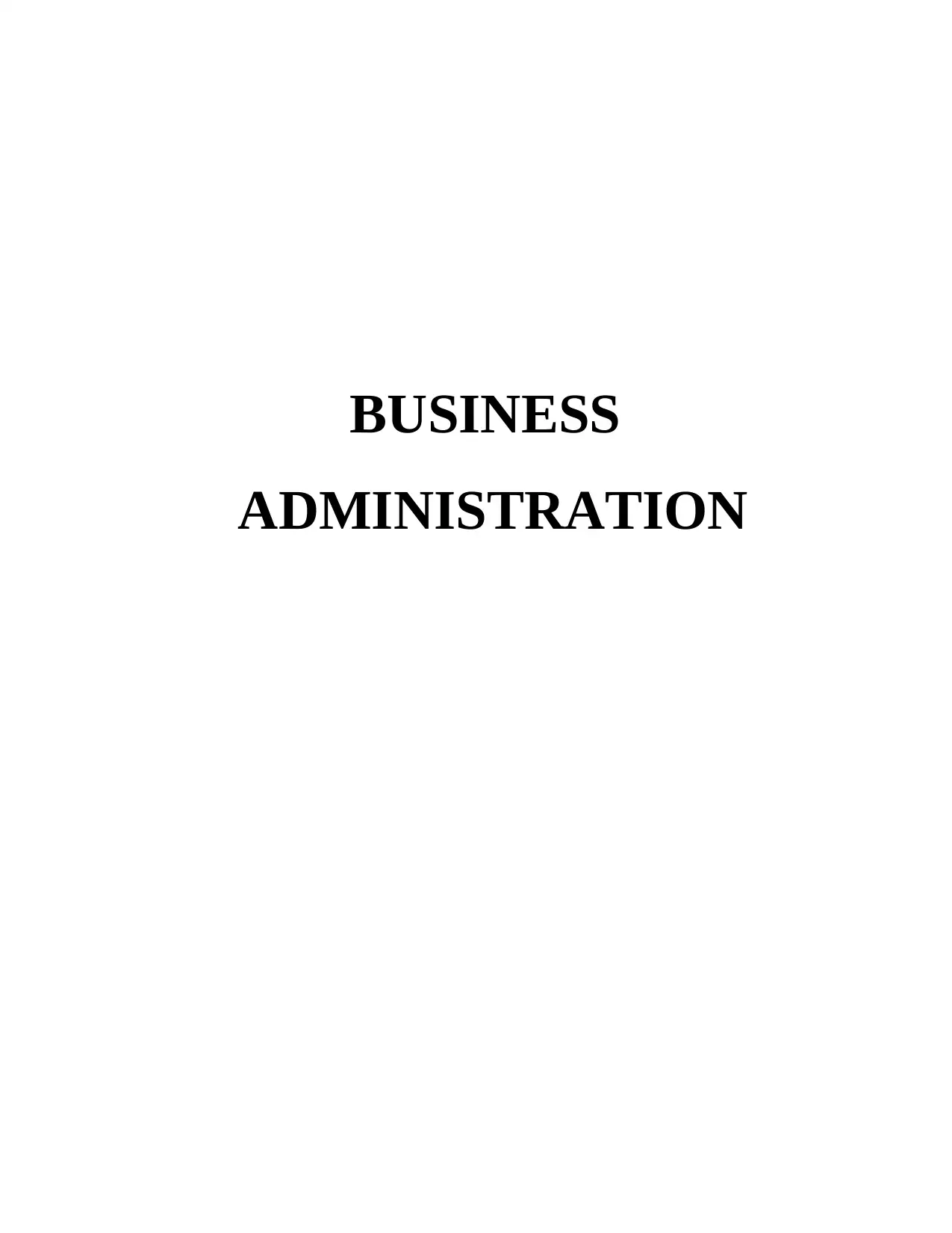
BUSINESS
ADMINISTRATION
ADMINISTRATION
Paraphrase This Document
Need a fresh take? Get an instant paraphrase of this document with our AI Paraphraser
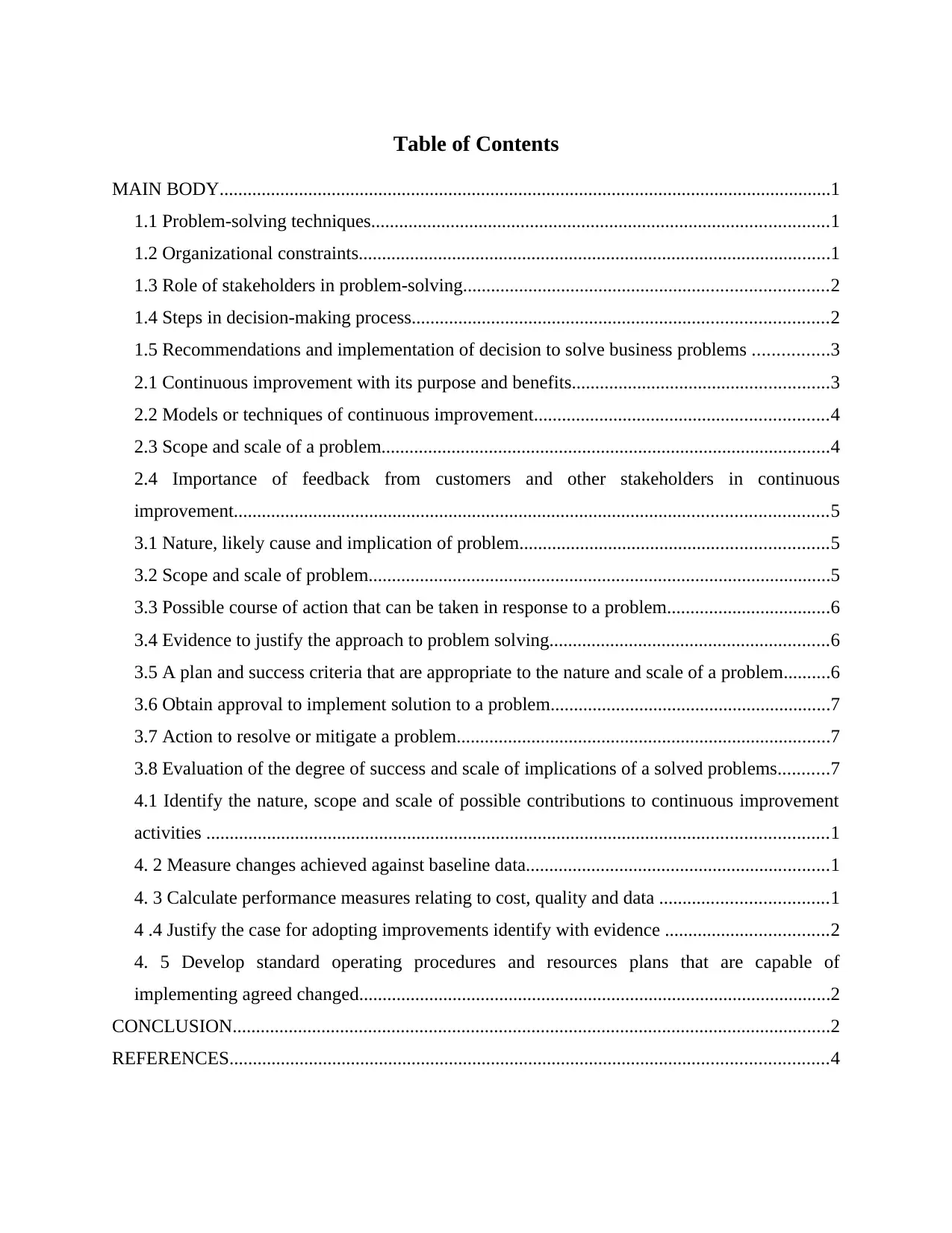
Table of Contents
MAIN BODY...................................................................................................................................1
1.1 Problem-solving techniques..................................................................................................1
1.2 Organizational constraints.....................................................................................................1
1.3 Role of stakeholders in problem-solving..............................................................................2
1.4 Steps in decision-making process.........................................................................................2
1.5 Recommendations and implementation of decision to solve business problems ................3
2.1 Continuous improvement with its purpose and benefits.......................................................3
2.2 Models or techniques of continuous improvement...............................................................4
2.3 Scope and scale of a problem................................................................................................4
2.4 Importance of feedback from customers and other stakeholders in continuous
improvement...............................................................................................................................5
3.1 Nature, likely cause and implication of problem..................................................................5
3.2 Scope and scale of problem...................................................................................................5
3.3 Possible course of action that can be taken in response to a problem...................................6
3.4 Evidence to justify the approach to problem solving............................................................6
3.5 A plan and success criteria that are appropriate to the nature and scale of a problem..........6
3.6 Obtain approval to implement solution to a problem............................................................7
3.7 Action to resolve or mitigate a problem................................................................................7
3.8 Evaluation of the degree of success and scale of implications of a solved problems...........7
4.1 Identify the nature, scope and scale of possible contributions to continuous improvement
activities .....................................................................................................................................1
4. 2 Measure changes achieved against baseline data.................................................................1
4. 3 Calculate performance measures relating to cost, quality and data ....................................1
4 .4 Justify the case for adopting improvements identify with evidence ...................................2
4. 5 Develop standard operating procedures and resources plans that are capable of
implementing agreed changed.....................................................................................................2
CONCLUSION................................................................................................................................2
REFERENCES................................................................................................................................4
MAIN BODY...................................................................................................................................1
1.1 Problem-solving techniques..................................................................................................1
1.2 Organizational constraints.....................................................................................................1
1.3 Role of stakeholders in problem-solving..............................................................................2
1.4 Steps in decision-making process.........................................................................................2
1.5 Recommendations and implementation of decision to solve business problems ................3
2.1 Continuous improvement with its purpose and benefits.......................................................3
2.2 Models or techniques of continuous improvement...............................................................4
2.3 Scope and scale of a problem................................................................................................4
2.4 Importance of feedback from customers and other stakeholders in continuous
improvement...............................................................................................................................5
3.1 Nature, likely cause and implication of problem..................................................................5
3.2 Scope and scale of problem...................................................................................................5
3.3 Possible course of action that can be taken in response to a problem...................................6
3.4 Evidence to justify the approach to problem solving............................................................6
3.5 A plan and success criteria that are appropriate to the nature and scale of a problem..........6
3.6 Obtain approval to implement solution to a problem............................................................7
3.7 Action to resolve or mitigate a problem................................................................................7
3.8 Evaluation of the degree of success and scale of implications of a solved problems...........7
4.1 Identify the nature, scope and scale of possible contributions to continuous improvement
activities .....................................................................................................................................1
4. 2 Measure changes achieved against baseline data.................................................................1
4. 3 Calculate performance measures relating to cost, quality and data ....................................1
4 .4 Justify the case for adopting improvements identify with evidence ...................................2
4. 5 Develop standard operating procedures and resources plans that are capable of
implementing agreed changed.....................................................................................................2
CONCLUSION................................................................................................................................2
REFERENCES................................................................................................................................4
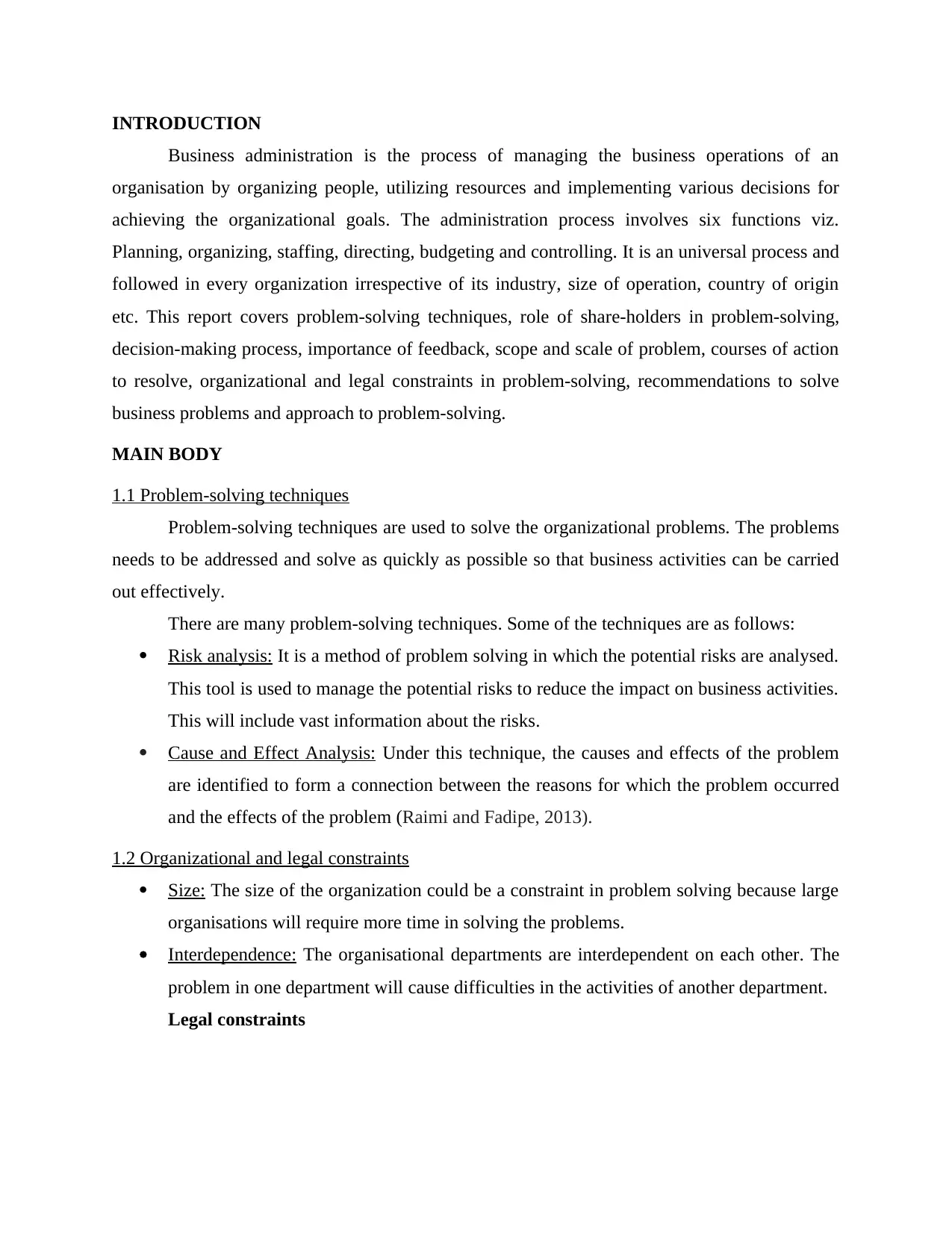
INTRODUCTION
Business administration is the process of managing the business operations of an
organisation by organizing people, utilizing resources and implementing various decisions for
achieving the organizational goals. The administration process involves six functions viz.
Planning, organizing, staffing, directing, budgeting and controlling. It is an universal process and
followed in every organization irrespective of its industry, size of operation, country of origin
etc. This report covers problem-solving techniques, role of share-holders in problem-solving,
decision-making process, importance of feedback, scope and scale of problem, courses of action
to resolve, organizational and legal constraints in problem-solving, recommendations to solve
business problems and approach to problem-solving.
MAIN BODY
1.1 Problem-solving techniques
Problem-solving techniques are used to solve the organizational problems. The problems
needs to be addressed and solve as quickly as possible so that business activities can be carried
out effectively.
There are many problem-solving techniques. Some of the techniques are as follows:
Risk analysis: It is a method of problem solving in which the potential risks are analysed.
This tool is used to manage the potential risks to reduce the impact on business activities.
This will include vast information about the risks.
Cause and Effect Analysis: Under this technique, the causes and effects of the problem
are identified to form a connection between the reasons for which the problem occurred
and the effects of the problem (Raimi and Fadipe, 2013).
1.2 Organizational and legal constraints
Size: The size of the organization could be a constraint in problem solving because large
organisations will require more time in solving the problems.
Interdependence: The organisational departments are interdependent on each other. The
problem in one department will cause difficulties in the activities of another department.
Legal constraints
Business administration is the process of managing the business operations of an
organisation by organizing people, utilizing resources and implementing various decisions for
achieving the organizational goals. The administration process involves six functions viz.
Planning, organizing, staffing, directing, budgeting and controlling. It is an universal process and
followed in every organization irrespective of its industry, size of operation, country of origin
etc. This report covers problem-solving techniques, role of share-holders in problem-solving,
decision-making process, importance of feedback, scope and scale of problem, courses of action
to resolve, organizational and legal constraints in problem-solving, recommendations to solve
business problems and approach to problem-solving.
MAIN BODY
1.1 Problem-solving techniques
Problem-solving techniques are used to solve the organizational problems. The problems
needs to be addressed and solve as quickly as possible so that business activities can be carried
out effectively.
There are many problem-solving techniques. Some of the techniques are as follows:
Risk analysis: It is a method of problem solving in which the potential risks are analysed.
This tool is used to manage the potential risks to reduce the impact on business activities.
This will include vast information about the risks.
Cause and Effect Analysis: Under this technique, the causes and effects of the problem
are identified to form a connection between the reasons for which the problem occurred
and the effects of the problem (Raimi and Fadipe, 2013).
1.2 Organizational and legal constraints
Size: The size of the organization could be a constraint in problem solving because large
organisations will require more time in solving the problems.
Interdependence: The organisational departments are interdependent on each other. The
problem in one department will cause difficulties in the activities of another department.
Legal constraints
⊘ This is a preview!⊘
Do you want full access?
Subscribe today to unlock all pages.

Trusted by 1+ million students worldwide
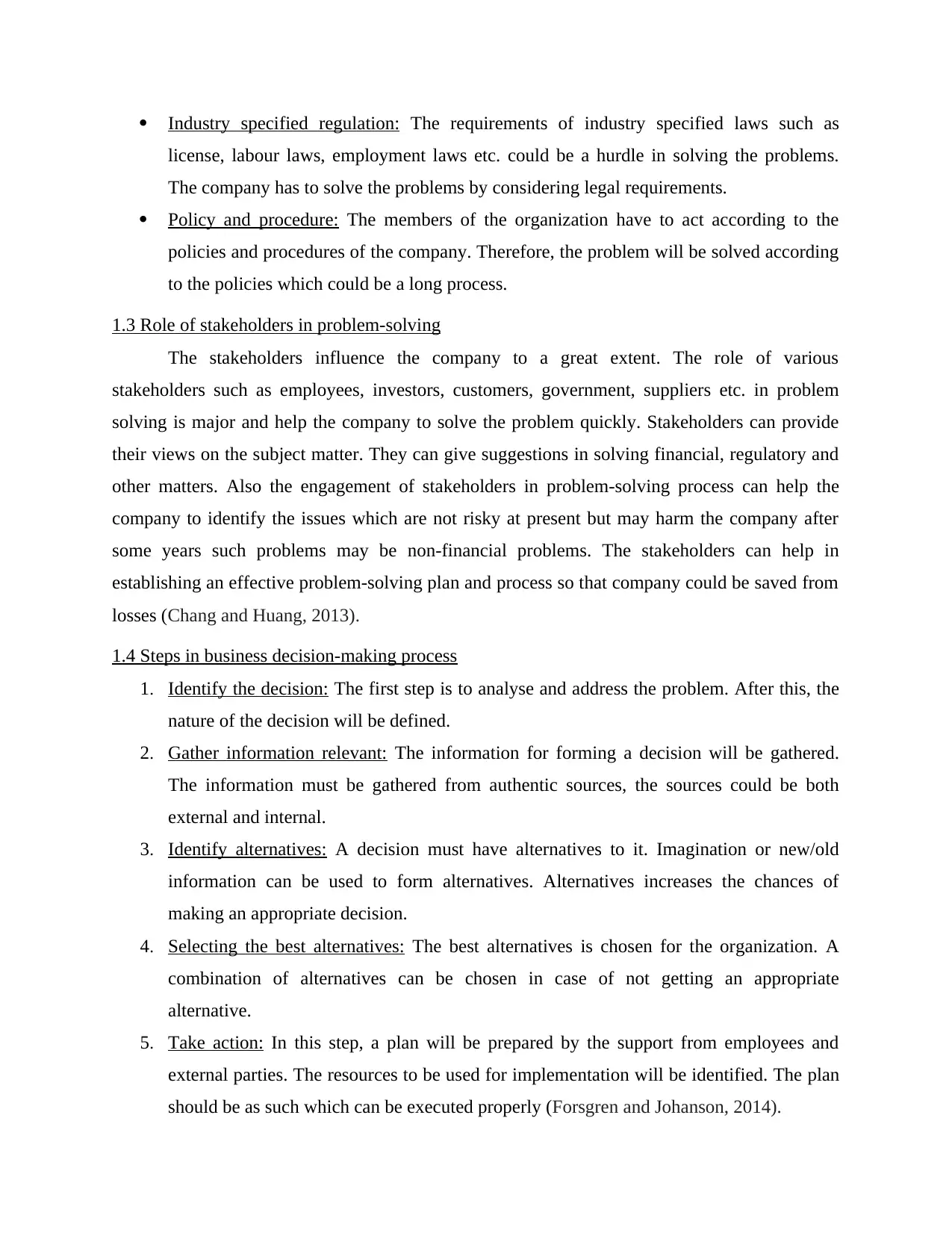
Industry specified regulation: The requirements of industry specified laws such as
license, labour laws, employment laws etc. could be a hurdle in solving the problems.
The company has to solve the problems by considering legal requirements.
Policy and procedure: The members of the organization have to act according to the
policies and procedures of the company. Therefore, the problem will be solved according
to the policies which could be a long process.
1.3 Role of stakeholders in problem-solving
The stakeholders influence the company to a great extent. The role of various
stakeholders such as employees, investors, customers, government, suppliers etc. in problem
solving is major and help the company to solve the problem quickly. Stakeholders can provide
their views on the subject matter. They can give suggestions in solving financial, regulatory and
other matters. Also the engagement of stakeholders in problem-solving process can help the
company to identify the issues which are not risky at present but may harm the company after
some years such problems may be non-financial problems. The stakeholders can help in
establishing an effective problem-solving plan and process so that company could be saved from
losses (Chang and Huang, 2013).
1.4 Steps in business decision-making process
1. Identify the decision: The first step is to analyse and address the problem. After this, the
nature of the decision will be defined.
2. Gather information relevant: The information for forming a decision will be gathered.
The information must be gathered from authentic sources, the sources could be both
external and internal.
3. Identify alternatives: A decision must have alternatives to it. Imagination or new/old
information can be used to form alternatives. Alternatives increases the chances of
making an appropriate decision.
4. Selecting the best alternatives: The best alternatives is chosen for the organization. A
combination of alternatives can be chosen in case of not getting an appropriate
alternative.
5. Take action: In this step, a plan will be prepared by the support from employees and
external parties. The resources to be used for implementation will be identified. The plan
should be as such which can be executed properly (Forsgren and Johanson, 2014).
license, labour laws, employment laws etc. could be a hurdle in solving the problems.
The company has to solve the problems by considering legal requirements.
Policy and procedure: The members of the organization have to act according to the
policies and procedures of the company. Therefore, the problem will be solved according
to the policies which could be a long process.
1.3 Role of stakeholders in problem-solving
The stakeholders influence the company to a great extent. The role of various
stakeholders such as employees, investors, customers, government, suppliers etc. in problem
solving is major and help the company to solve the problem quickly. Stakeholders can provide
their views on the subject matter. They can give suggestions in solving financial, regulatory and
other matters. Also the engagement of stakeholders in problem-solving process can help the
company to identify the issues which are not risky at present but may harm the company after
some years such problems may be non-financial problems. The stakeholders can help in
establishing an effective problem-solving plan and process so that company could be saved from
losses (Chang and Huang, 2013).
1.4 Steps in business decision-making process
1. Identify the decision: The first step is to analyse and address the problem. After this, the
nature of the decision will be defined.
2. Gather information relevant: The information for forming a decision will be gathered.
The information must be gathered from authentic sources, the sources could be both
external and internal.
3. Identify alternatives: A decision must have alternatives to it. Imagination or new/old
information can be used to form alternatives. Alternatives increases the chances of
making an appropriate decision.
4. Selecting the best alternatives: The best alternatives is chosen for the organization. A
combination of alternatives can be chosen in case of not getting an appropriate
alternative.
5. Take action: In this step, a plan will be prepared by the support from employees and
external parties. The resources to be used for implementation will be identified. The plan
should be as such which can be executed properly (Forsgren and Johanson, 2014).
Paraphrase This Document
Need a fresh take? Get an instant paraphrase of this document with our AI Paraphraser
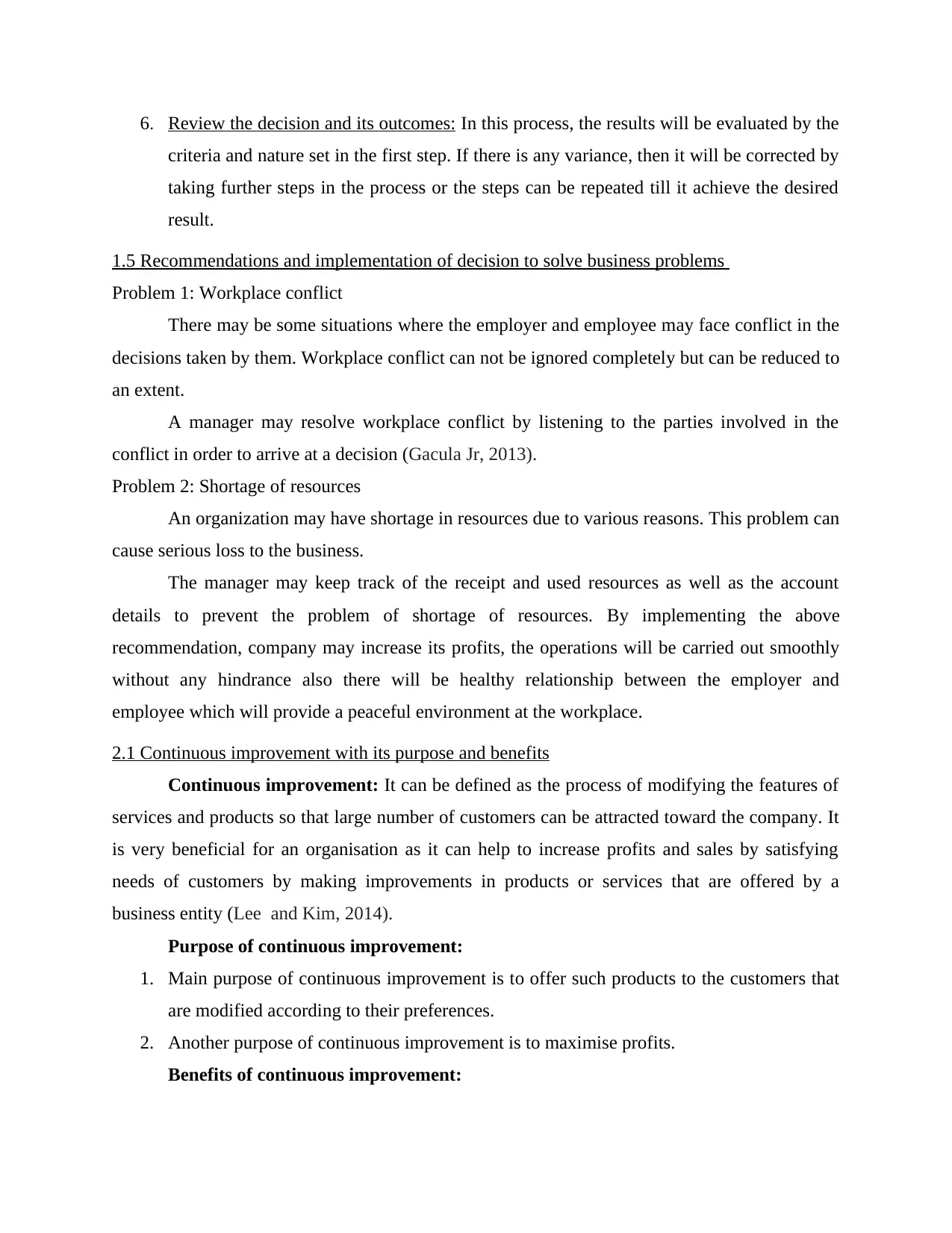
6. Review the decision and its outcomes: In this process, the results will be evaluated by the
criteria and nature set in the first step. If there is any variance, then it will be corrected by
taking further steps in the process or the steps can be repeated till it achieve the desired
result.
1.5 Recommendations and implementation of decision to solve business problems
Problem 1: Workplace conflict
There may be some situations where the employer and employee may face conflict in the
decisions taken by them. Workplace conflict can not be ignored completely but can be reduced to
an extent.
A manager may resolve workplace conflict by listening to the parties involved in the
conflict in order to arrive at a decision (Gacula Jr, 2013).
Problem 2: Shortage of resources
An organization may have shortage in resources due to various reasons. This problem can
cause serious loss to the business.
The manager may keep track of the receipt and used resources as well as the account
details to prevent the problem of shortage of resources. By implementing the above
recommendation, company may increase its profits, the operations will be carried out smoothly
without any hindrance also there will be healthy relationship between the employer and
employee which will provide a peaceful environment at the workplace.
2.1 Continuous improvement with its purpose and benefits
Continuous improvement: It can be defined as the process of modifying the features of
services and products so that large number of customers can be attracted toward the company. It
is very beneficial for an organisation as it can help to increase profits and sales by satisfying
needs of customers by making improvements in products or services that are offered by a
business entity (Lee and Kim, 2014).
Purpose of continuous improvement:
1. Main purpose of continuous improvement is to offer such products to the customers that
are modified according to their preferences.
2. Another purpose of continuous improvement is to maximise profits.
Benefits of continuous improvement:
criteria and nature set in the first step. If there is any variance, then it will be corrected by
taking further steps in the process or the steps can be repeated till it achieve the desired
result.
1.5 Recommendations and implementation of decision to solve business problems
Problem 1: Workplace conflict
There may be some situations where the employer and employee may face conflict in the
decisions taken by them. Workplace conflict can not be ignored completely but can be reduced to
an extent.
A manager may resolve workplace conflict by listening to the parties involved in the
conflict in order to arrive at a decision (Gacula Jr, 2013).
Problem 2: Shortage of resources
An organization may have shortage in resources due to various reasons. This problem can
cause serious loss to the business.
The manager may keep track of the receipt and used resources as well as the account
details to prevent the problem of shortage of resources. By implementing the above
recommendation, company may increase its profits, the operations will be carried out smoothly
without any hindrance also there will be healthy relationship between the employer and
employee which will provide a peaceful environment at the workplace.
2.1 Continuous improvement with its purpose and benefits
Continuous improvement: It can be defined as the process of modifying the features of
services and products so that large number of customers can be attracted toward the company. It
is very beneficial for an organisation as it can help to increase profits and sales by satisfying
needs of customers by making improvements in products or services that are offered by a
business entity (Lee and Kim, 2014).
Purpose of continuous improvement:
1. Main purpose of continuous improvement is to offer such products to the customers that
are modified according to their preferences.
2. Another purpose of continuous improvement is to maximise profits.
Benefits of continuous improvement:
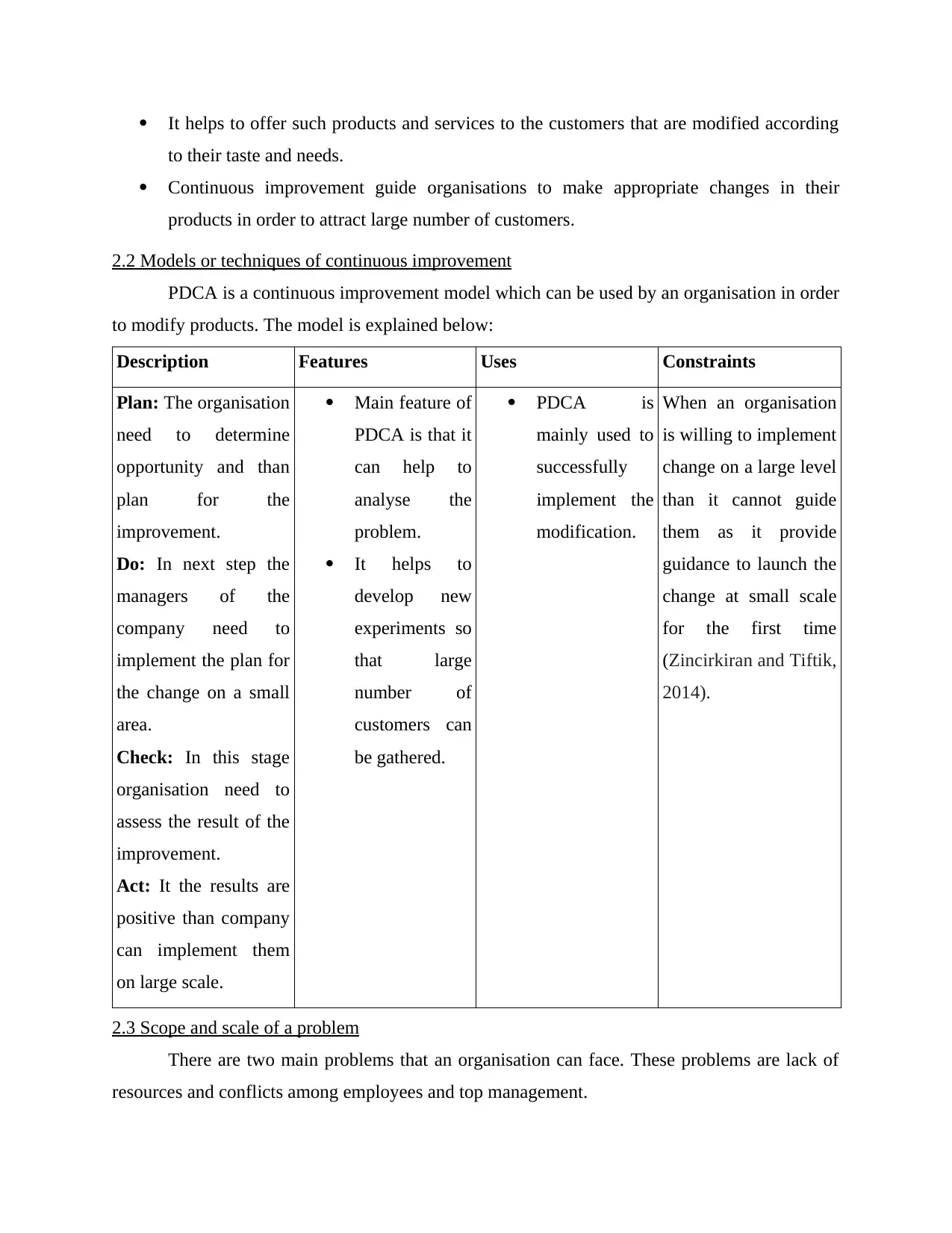
It helps to offer such products and services to the customers that are modified according
to their taste and needs.
Continuous improvement guide organisations to make appropriate changes in their
products in order to attract large number of customers.
2.2 Models or techniques of continuous improvement
PDCA is a continuous improvement model which can be used by an organisation in order
to modify products. The model is explained below:
Description Features Uses Constraints
Plan: The organisation
need to determine
opportunity and than
plan for the
improvement.
Do: In next step the
managers of the
company need to
implement the plan for
the change on a small
area.
Check: In this stage
organisation need to
assess the result of the
improvement.
Act: It the results are
positive than company
can implement them
on large scale.
Main feature of
PDCA is that it
can help to
analyse the
problem.
It helps to
develop new
experiments so
that large
number of
customers can
be gathered.
PDCA is
mainly used to
successfully
implement the
modification.
When an organisation
is willing to implement
change on a large level
than it cannot guide
them as it provide
guidance to launch the
change at small scale
for the first time
(Zincirkiran and Tiftik,
2014).
2.3 Scope and scale of a problem
There are two main problems that an organisation can face. These problems are lack of
resources and conflicts among employees and top management.
to their taste and needs.
Continuous improvement guide organisations to make appropriate changes in their
products in order to attract large number of customers.
2.2 Models or techniques of continuous improvement
PDCA is a continuous improvement model which can be used by an organisation in order
to modify products. The model is explained below:
Description Features Uses Constraints
Plan: The organisation
need to determine
opportunity and than
plan for the
improvement.
Do: In next step the
managers of the
company need to
implement the plan for
the change on a small
area.
Check: In this stage
organisation need to
assess the result of the
improvement.
Act: It the results are
positive than company
can implement them
on large scale.
Main feature of
PDCA is that it
can help to
analyse the
problem.
It helps to
develop new
experiments so
that large
number of
customers can
be gathered.
PDCA is
mainly used to
successfully
implement the
modification.
When an organisation
is willing to implement
change on a large level
than it cannot guide
them as it provide
guidance to launch the
change at small scale
for the first time
(Zincirkiran and Tiftik,
2014).
2.3 Scope and scale of a problem
There are two main problems that an organisation can face. These problems are lack of
resources and conflicts among employees and top management.
⊘ This is a preview!⊘
Do you want full access?
Subscribe today to unlock all pages.

Trusted by 1+ million students worldwide
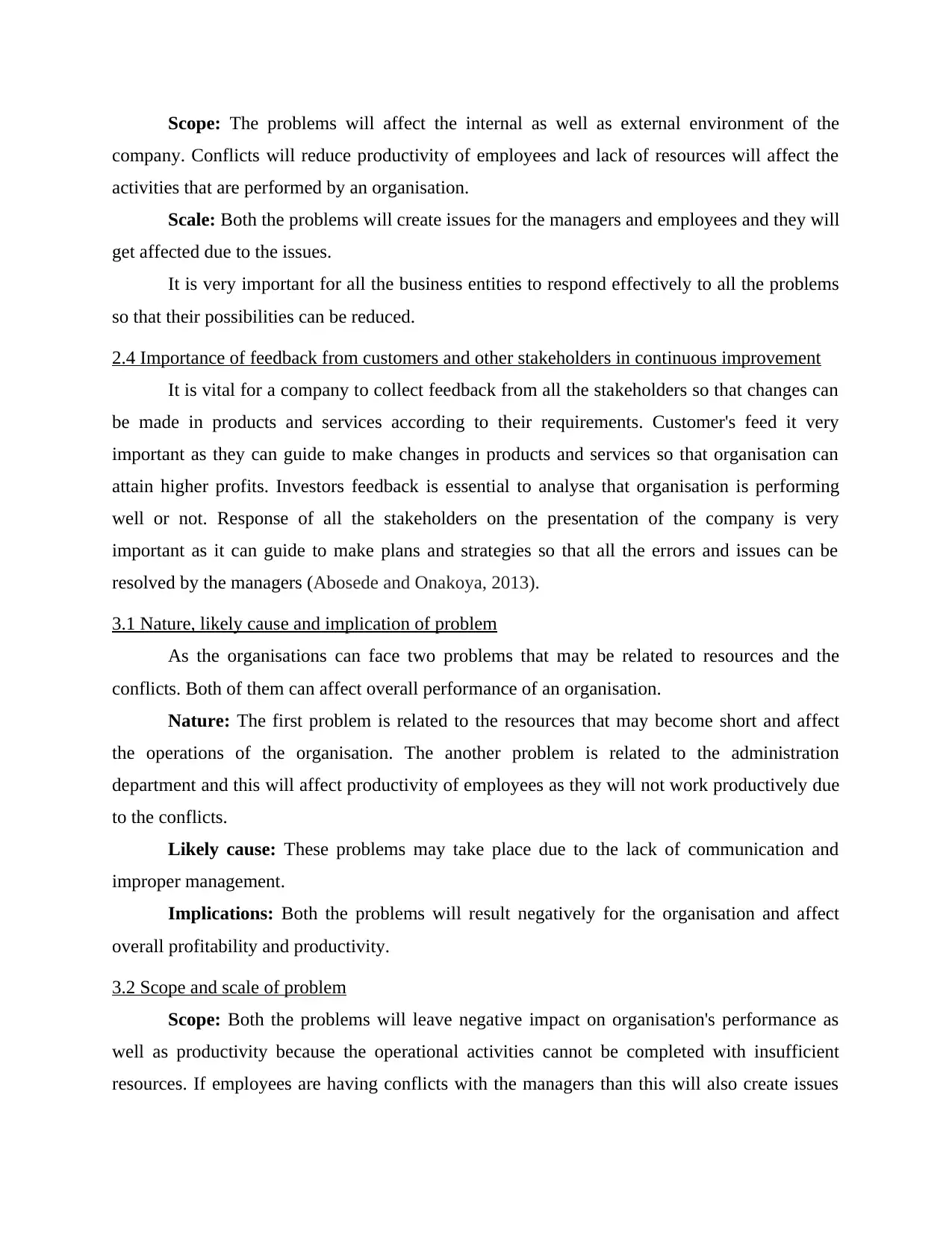
Scope: The problems will affect the internal as well as external environment of the
company. Conflicts will reduce productivity of employees and lack of resources will affect the
activities that are performed by an organisation.
Scale: Both the problems will create issues for the managers and employees and they will
get affected due to the issues.
It is very important for all the business entities to respond effectively to all the problems
so that their possibilities can be reduced.
2.4 Importance of feedback from customers and other stakeholders in continuous improvement
It is vital for a company to collect feedback from all the stakeholders so that changes can
be made in products and services according to their requirements. Customer's feed it very
important as they can guide to make changes in products and services so that organisation can
attain higher profits. Investors feedback is essential to analyse that organisation is performing
well or not. Response of all the stakeholders on the presentation of the company is very
important as it can guide to make plans and strategies so that all the errors and issues can be
resolved by the managers (Abosede and Onakoya, 2013).
3.1 Nature, likely cause and implication of problem
As the organisations can face two problems that may be related to resources and the
conflicts. Both of them can affect overall performance of an organisation.
Nature: The first problem is related to the resources that may become short and affect
the operations of the organisation. The another problem is related to the administration
department and this will affect productivity of employees as they will not work productively due
to the conflicts.
Likely cause: These problems may take place due to the lack of communication and
improper management.
Implications: Both the problems will result negatively for the organisation and affect
overall profitability and productivity.
3.2 Scope and scale of problem
Scope: Both the problems will leave negative impact on organisation's performance as
well as productivity because the operational activities cannot be completed with insufficient
resources. If employees are having conflicts with the managers than this will also create issues
company. Conflicts will reduce productivity of employees and lack of resources will affect the
activities that are performed by an organisation.
Scale: Both the problems will create issues for the managers and employees and they will
get affected due to the issues.
It is very important for all the business entities to respond effectively to all the problems
so that their possibilities can be reduced.
2.4 Importance of feedback from customers and other stakeholders in continuous improvement
It is vital for a company to collect feedback from all the stakeholders so that changes can
be made in products and services according to their requirements. Customer's feed it very
important as they can guide to make changes in products and services so that organisation can
attain higher profits. Investors feedback is essential to analyse that organisation is performing
well or not. Response of all the stakeholders on the presentation of the company is very
important as it can guide to make plans and strategies so that all the errors and issues can be
resolved by the managers (Abosede and Onakoya, 2013).
3.1 Nature, likely cause and implication of problem
As the organisations can face two problems that may be related to resources and the
conflicts. Both of them can affect overall performance of an organisation.
Nature: The first problem is related to the resources that may become short and affect
the operations of the organisation. The another problem is related to the administration
department and this will affect productivity of employees as they will not work productively due
to the conflicts.
Likely cause: These problems may take place due to the lack of communication and
improper management.
Implications: Both the problems will result negatively for the organisation and affect
overall profitability and productivity.
3.2 Scope and scale of problem
Scope: Both the problems will leave negative impact on organisation's performance as
well as productivity because the operational activities cannot be completed with insufficient
resources. If employees are having conflicts with the managers than this will also create issues
Paraphrase This Document
Need a fresh take? Get an instant paraphrase of this document with our AI Paraphraser
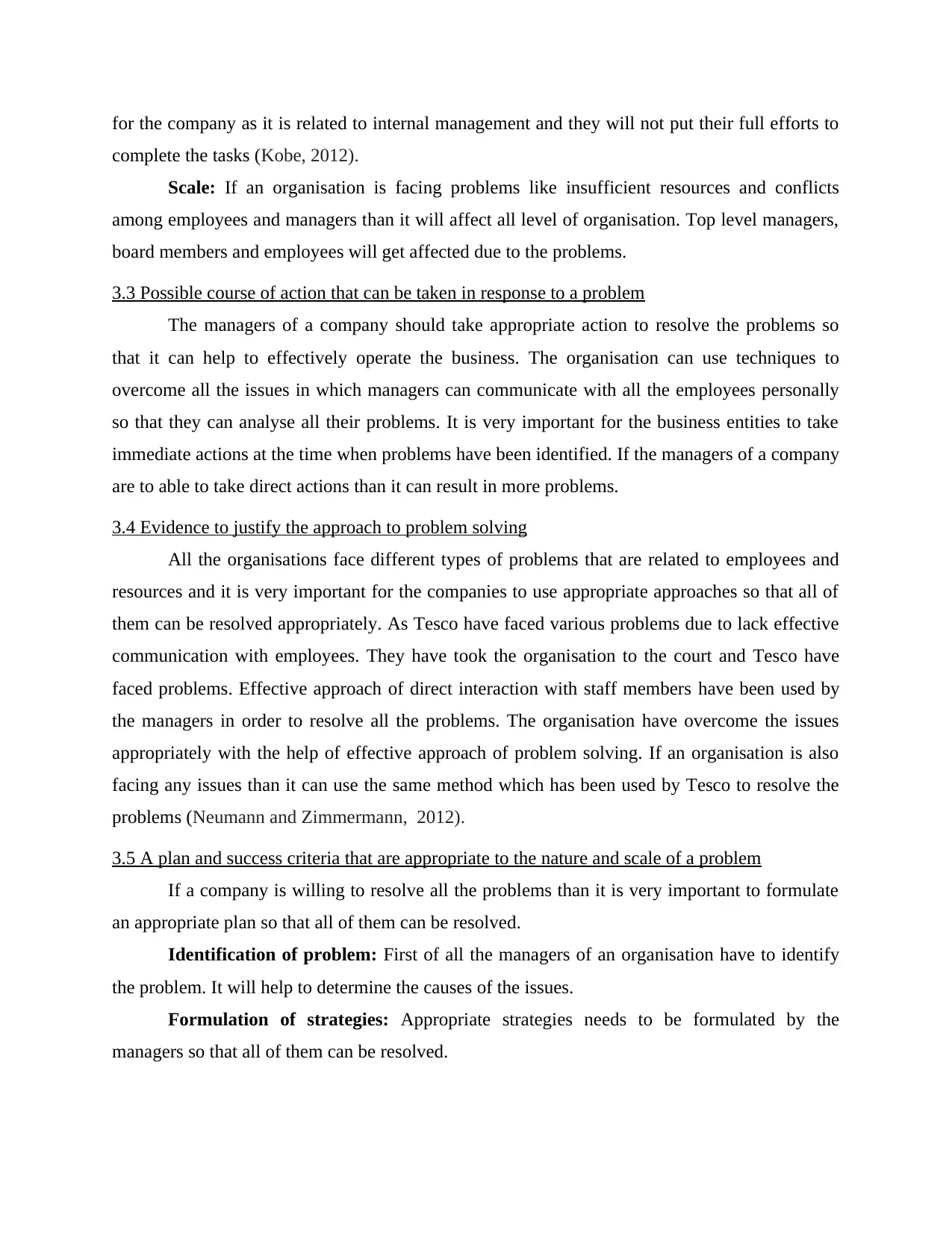
for the company as it is related to internal management and they will not put their full efforts to
complete the tasks (Kobe, 2012).
Scale: If an organisation is facing problems like insufficient resources and conflicts
among employees and managers than it will affect all level of organisation. Top level managers,
board members and employees will get affected due to the problems.
3.3 Possible course of action that can be taken in response to a problem
The managers of a company should take appropriate action to resolve the problems so
that it can help to effectively operate the business. The organisation can use techniques to
overcome all the issues in which managers can communicate with all the employees personally
so that they can analyse all their problems. It is very important for the business entities to take
immediate actions at the time when problems have been identified. If the managers of a company
are to able to take direct actions than it can result in more problems.
3.4 Evidence to justify the approach to problem solving
All the organisations face different types of problems that are related to employees and
resources and it is very important for the companies to use appropriate approaches so that all of
them can be resolved appropriately. As Tesco have faced various problems due to lack effective
communication with employees. They have took the organisation to the court and Tesco have
faced problems. Effective approach of direct interaction with staff members have been used by
the managers in order to resolve all the problems. The organisation have overcome the issues
appropriately with the help of effective approach of problem solving. If an organisation is also
facing any issues than it can use the same method which has been used by Tesco to resolve the
problems (Neumann and Zimmermann, 2012).
3.5 A plan and success criteria that are appropriate to the nature and scale of a problem
If a company is willing to resolve all the problems than it is very important to formulate
an appropriate plan so that all of them can be resolved.
Identification of problem: First of all the managers of an organisation have to identify
the problem. It will help to determine the causes of the issues.
Formulation of strategies: Appropriate strategies needs to be formulated by the
managers so that all of them can be resolved.
complete the tasks (Kobe, 2012).
Scale: If an organisation is facing problems like insufficient resources and conflicts
among employees and managers than it will affect all level of organisation. Top level managers,
board members and employees will get affected due to the problems.
3.3 Possible course of action that can be taken in response to a problem
The managers of a company should take appropriate action to resolve the problems so
that it can help to effectively operate the business. The organisation can use techniques to
overcome all the issues in which managers can communicate with all the employees personally
so that they can analyse all their problems. It is very important for the business entities to take
immediate actions at the time when problems have been identified. If the managers of a company
are to able to take direct actions than it can result in more problems.
3.4 Evidence to justify the approach to problem solving
All the organisations face different types of problems that are related to employees and
resources and it is very important for the companies to use appropriate approaches so that all of
them can be resolved appropriately. As Tesco have faced various problems due to lack effective
communication with employees. They have took the organisation to the court and Tesco have
faced problems. Effective approach of direct interaction with staff members have been used by
the managers in order to resolve all the problems. The organisation have overcome the issues
appropriately with the help of effective approach of problem solving. If an organisation is also
facing any issues than it can use the same method which has been used by Tesco to resolve the
problems (Neumann and Zimmermann, 2012).
3.5 A plan and success criteria that are appropriate to the nature and scale of a problem
If a company is willing to resolve all the problems than it is very important to formulate
an appropriate plan so that all of them can be resolved.
Identification of problem: First of all the managers of an organisation have to identify
the problem. It will help to determine the causes of the issues.
Formulation of strategies: Appropriate strategies needs to be formulated by the
managers so that all of them can be resolved.
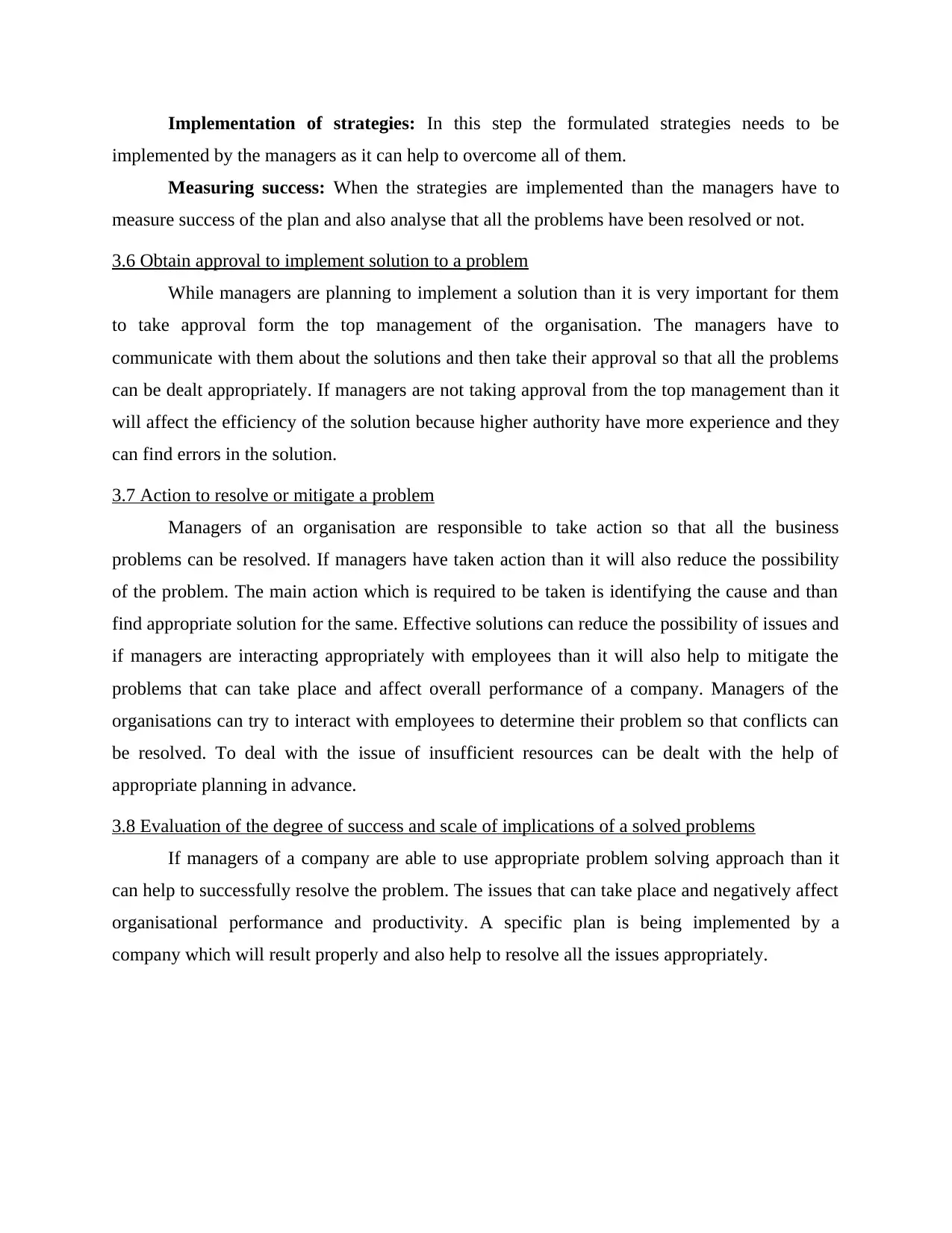
Implementation of strategies: In this step the formulated strategies needs to be
implemented by the managers as it can help to overcome all of them.
Measuring success: When the strategies are implemented than the managers have to
measure success of the plan and also analyse that all the problems have been resolved or not.
3.6 Obtain approval to implement solution to a problem
While managers are planning to implement a solution than it is very important for them
to take approval form the top management of the organisation. The managers have to
communicate with them about the solutions and then take their approval so that all the problems
can be dealt appropriately. If managers are not taking approval from the top management than it
will affect the efficiency of the solution because higher authority have more experience and they
can find errors in the solution.
3.7 Action to resolve or mitigate a problem
Managers of an organisation are responsible to take action so that all the business
problems can be resolved. If managers have taken action than it will also reduce the possibility
of the problem. The main action which is required to be taken is identifying the cause and than
find appropriate solution for the same. Effective solutions can reduce the possibility of issues and
if managers are interacting appropriately with employees than it will also help to mitigate the
problems that can take place and affect overall performance of a company. Managers of the
organisations can try to interact with employees to determine their problem so that conflicts can
be resolved. To deal with the issue of insufficient resources can be dealt with the help of
appropriate planning in advance.
3.8 Evaluation of the degree of success and scale of implications of a solved problems
If managers of a company are able to use appropriate problem solving approach than it
can help to successfully resolve the problem. The issues that can take place and negatively affect
organisational performance and productivity. A specific plan is being implemented by a
company which will result properly and also help to resolve all the issues appropriately.
implemented by the managers as it can help to overcome all of them.
Measuring success: When the strategies are implemented than the managers have to
measure success of the plan and also analyse that all the problems have been resolved or not.
3.6 Obtain approval to implement solution to a problem
While managers are planning to implement a solution than it is very important for them
to take approval form the top management of the organisation. The managers have to
communicate with them about the solutions and then take their approval so that all the problems
can be dealt appropriately. If managers are not taking approval from the top management than it
will affect the efficiency of the solution because higher authority have more experience and they
can find errors in the solution.
3.7 Action to resolve or mitigate a problem
Managers of an organisation are responsible to take action so that all the business
problems can be resolved. If managers have taken action than it will also reduce the possibility
of the problem. The main action which is required to be taken is identifying the cause and than
find appropriate solution for the same. Effective solutions can reduce the possibility of issues and
if managers are interacting appropriately with employees than it will also help to mitigate the
problems that can take place and affect overall performance of a company. Managers of the
organisations can try to interact with employees to determine their problem so that conflicts can
be resolved. To deal with the issue of insufficient resources can be dealt with the help of
appropriate planning in advance.
3.8 Evaluation of the degree of success and scale of implications of a solved problems
If managers of a company are able to use appropriate problem solving approach than it
can help to successfully resolve the problem. The issues that can take place and negatively affect
organisational performance and productivity. A specific plan is being implemented by a
company which will result properly and also help to resolve all the issues appropriately.
⊘ This is a preview!⊘
Do you want full access?
Subscribe today to unlock all pages.

Trusted by 1+ million students worldwide
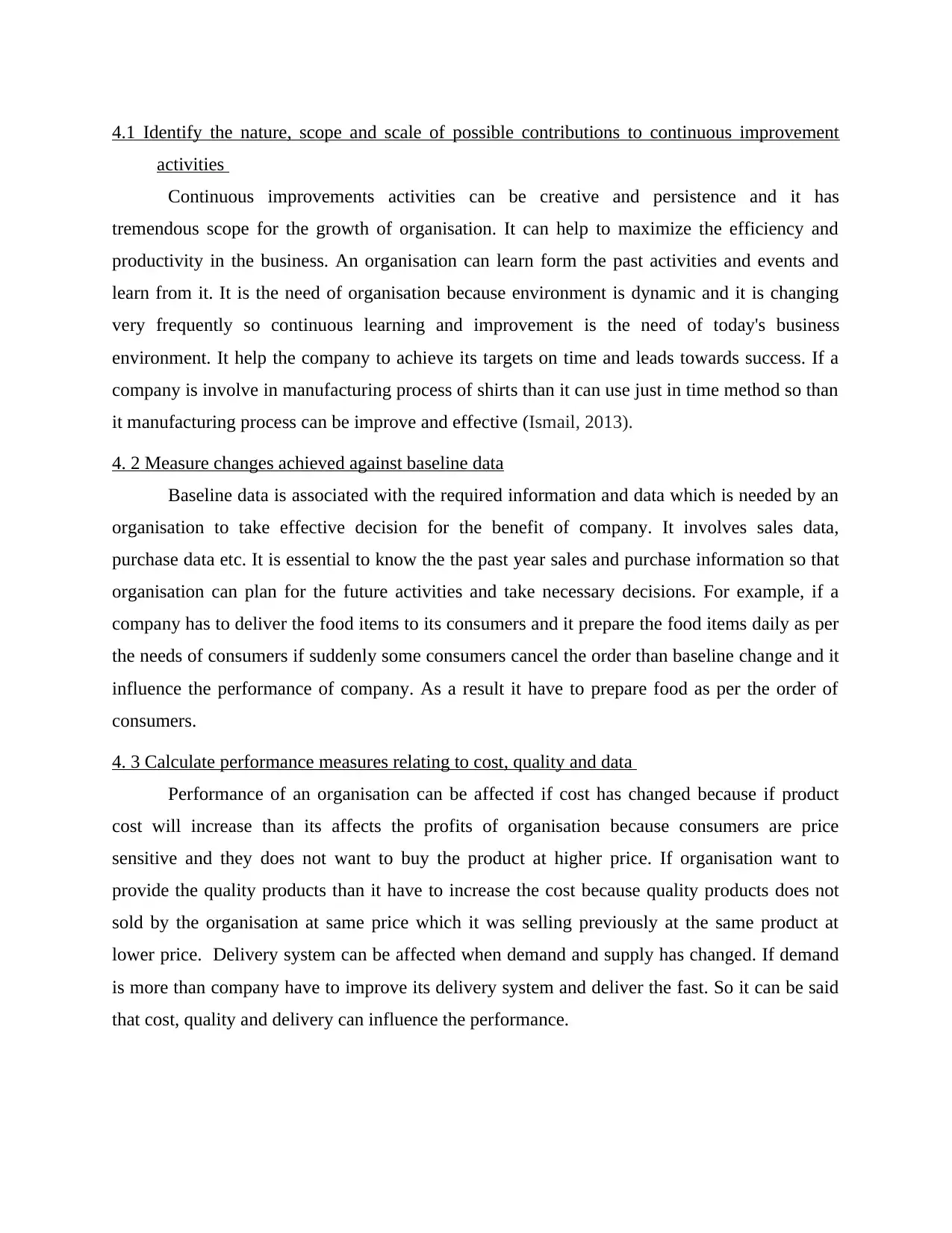
4.1 Identify the nature, scope and scale of possible contributions to continuous improvement
activities
Continuous improvements activities can be creative and persistence and it has
tremendous scope for the growth of organisation. It can help to maximize the efficiency and
productivity in the business. An organisation can learn form the past activities and events and
learn from it. It is the need of organisation because environment is dynamic and it is changing
very frequently so continuous learning and improvement is the need of today's business
environment. It help the company to achieve its targets on time and leads towards success. If a
company is involve in manufacturing process of shirts than it can use just in time method so than
it manufacturing process can be improve and effective (Ismail, 2013).
4. 2 Measure changes achieved against baseline data
Baseline data is associated with the required information and data which is needed by an
organisation to take effective decision for the benefit of company. It involves sales data,
purchase data etc. It is essential to know the the past year sales and purchase information so that
organisation can plan for the future activities and take necessary decisions. For example, if a
company has to deliver the food items to its consumers and it prepare the food items daily as per
the needs of consumers if suddenly some consumers cancel the order than baseline change and it
influence the performance of company. As a result it have to prepare food as per the order of
consumers.
4. 3 Calculate performance measures relating to cost, quality and data
Performance of an organisation can be affected if cost has changed because if product
cost will increase than its affects the profits of organisation because consumers are price
sensitive and they does not want to buy the product at higher price. If organisation want to
provide the quality products than it have to increase the cost because quality products does not
sold by the organisation at same price which it was selling previously at the same product at
lower price. Delivery system can be affected when demand and supply has changed. If demand
is more than company have to improve its delivery system and deliver the fast. So it can be said
that cost, quality and delivery can influence the performance.
activities
Continuous improvements activities can be creative and persistence and it has
tremendous scope for the growth of organisation. It can help to maximize the efficiency and
productivity in the business. An organisation can learn form the past activities and events and
learn from it. It is the need of organisation because environment is dynamic and it is changing
very frequently so continuous learning and improvement is the need of today's business
environment. It help the company to achieve its targets on time and leads towards success. If a
company is involve in manufacturing process of shirts than it can use just in time method so than
it manufacturing process can be improve and effective (Ismail, 2013).
4. 2 Measure changes achieved against baseline data
Baseline data is associated with the required information and data which is needed by an
organisation to take effective decision for the benefit of company. It involves sales data,
purchase data etc. It is essential to know the the past year sales and purchase information so that
organisation can plan for the future activities and take necessary decisions. For example, if a
company has to deliver the food items to its consumers and it prepare the food items daily as per
the needs of consumers if suddenly some consumers cancel the order than baseline change and it
influence the performance of company. As a result it have to prepare food as per the order of
consumers.
4. 3 Calculate performance measures relating to cost, quality and data
Performance of an organisation can be affected if cost has changed because if product
cost will increase than its affects the profits of organisation because consumers are price
sensitive and they does not want to buy the product at higher price. If organisation want to
provide the quality products than it have to increase the cost because quality products does not
sold by the organisation at same price which it was selling previously at the same product at
lower price. Delivery system can be affected when demand and supply has changed. If demand
is more than company have to improve its delivery system and deliver the fast. So it can be said
that cost, quality and delivery can influence the performance.
Paraphrase This Document
Need a fresh take? Get an instant paraphrase of this document with our AI Paraphraser
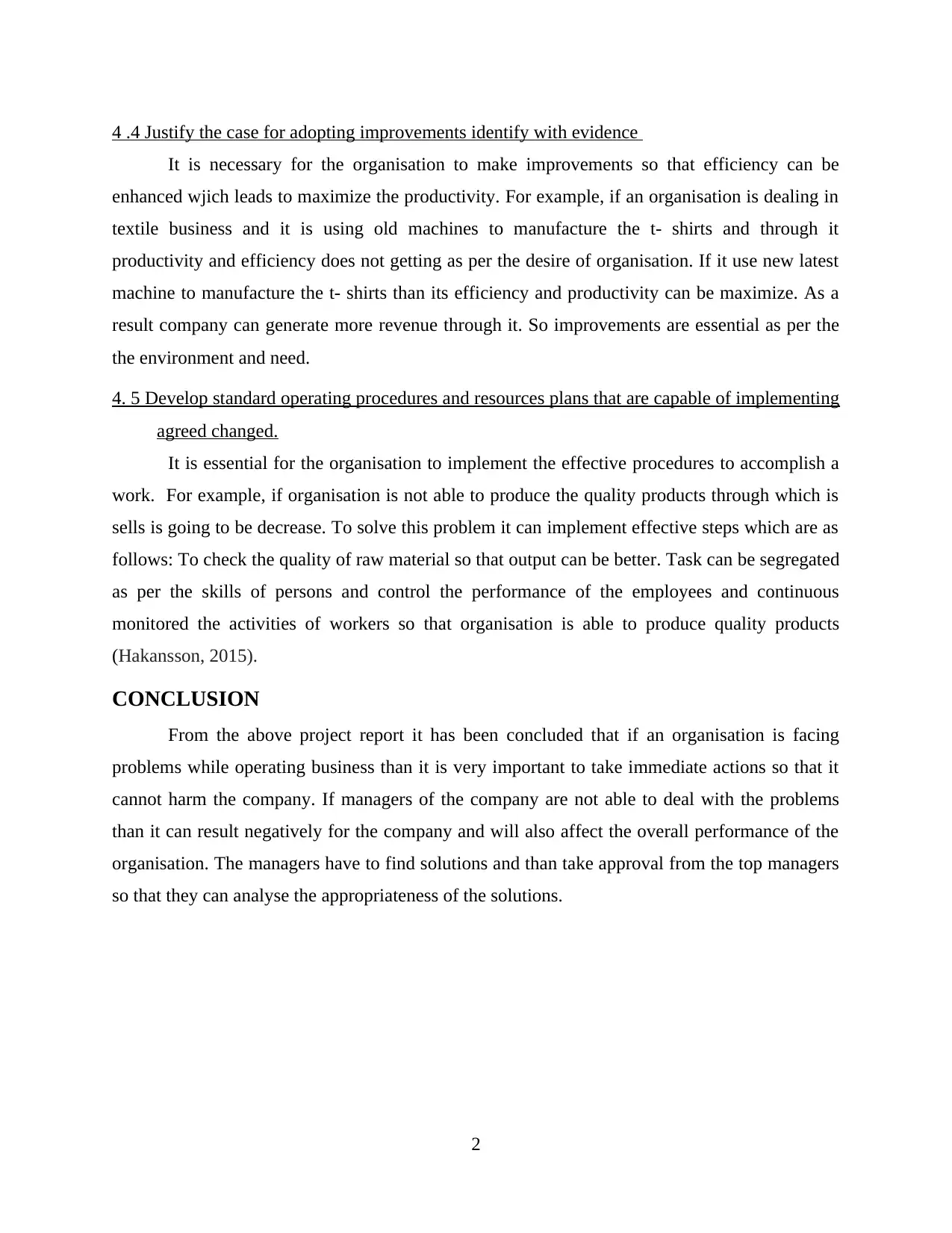
4 .4 Justify the case for adopting improvements identify with evidence
It is necessary for the organisation to make improvements so that efficiency can be
enhanced wjich leads to maximize the productivity. For example, if an organisation is dealing in
textile business and it is using old machines to manufacture the t- shirts and through it
productivity and efficiency does not getting as per the desire of organisation. If it use new latest
machine to manufacture the t- shirts than its efficiency and productivity can be maximize. As a
result company can generate more revenue through it. So improvements are essential as per the
the environment and need.
4. 5 Develop standard operating procedures and resources plans that are capable of implementing
agreed changed.
It is essential for the organisation to implement the effective procedures to accomplish a
work. For example, if organisation is not able to produce the quality products through which is
sells is going to be decrease. To solve this problem it can implement effective steps which are as
follows: To check the quality of raw material so that output can be better. Task can be segregated
as per the skills of persons and control the performance of the employees and continuous
monitored the activities of workers so that organisation is able to produce quality products
(Hakansson, 2015).
CONCLUSION
From the above project report it has been concluded that if an organisation is facing
problems while operating business than it is very important to take immediate actions so that it
cannot harm the company. If managers of the company are not able to deal with the problems
than it can result negatively for the company and will also affect the overall performance of the
organisation. The managers have to find solutions and than take approval from the top managers
so that they can analyse the appropriateness of the solutions.
2
It is necessary for the organisation to make improvements so that efficiency can be
enhanced wjich leads to maximize the productivity. For example, if an organisation is dealing in
textile business and it is using old machines to manufacture the t- shirts and through it
productivity and efficiency does not getting as per the desire of organisation. If it use new latest
machine to manufacture the t- shirts than its efficiency and productivity can be maximize. As a
result company can generate more revenue through it. So improvements are essential as per the
the environment and need.
4. 5 Develop standard operating procedures and resources plans that are capable of implementing
agreed changed.
It is essential for the organisation to implement the effective procedures to accomplish a
work. For example, if organisation is not able to produce the quality products through which is
sells is going to be decrease. To solve this problem it can implement effective steps which are as
follows: To check the quality of raw material so that output can be better. Task can be segregated
as per the skills of persons and control the performance of the employees and continuous
monitored the activities of workers so that organisation is able to produce quality products
(Hakansson, 2015).
CONCLUSION
From the above project report it has been concluded that if an organisation is facing
problems while operating business than it is very important to take immediate actions so that it
cannot harm the company. If managers of the company are not able to deal with the problems
than it can result negatively for the company and will also affect the overall performance of the
organisation. The managers have to find solutions and than take approval from the top managers
so that they can analyse the appropriateness of the solutions.
2

3
⊘ This is a preview!⊘
Do you want full access?
Subscribe today to unlock all pages.

Trusted by 1+ million students worldwide
1 out of 13
Related Documents
Your All-in-One AI-Powered Toolkit for Academic Success.
+13062052269
info@desklib.com
Available 24*7 on WhatsApp / Email
![[object Object]](/_next/static/media/star-bottom.7253800d.svg)
Unlock your academic potential
Copyright © 2020–2025 A2Z Services. All Rights Reserved. Developed and managed by ZUCOL.





